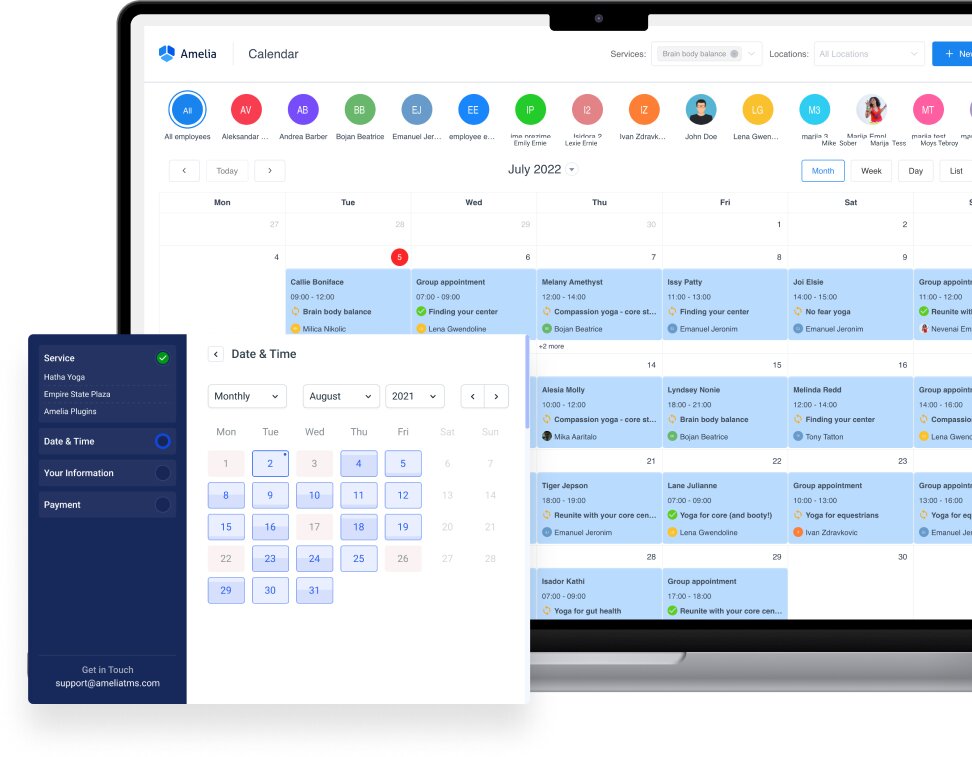Creating a work schedule that maximizes productivity is essential for any business, especially one belonging to the service industry. A well-designed work schedule can help employees prioritize tasks, stay focused, and meet deadlines, while also reducing stress and increasing job satisfaction.
However, creating such a schedule can be challenging, especially if you’re not sure where to start.
Whether you’re an individual looking to improve your own productivity or a manager seeking to optimize your team’s performance, this guide will provide you with practical tips and best practices to help you create a work schedule that works for you.
But first, let’s see what a work schedule is.
What Is a Work Schedule?

A work schedule is a pre-determined plan that outlines the specific hours and days an individual is required to work. It’s an essential tool used by both employees and employers to manage their time effectively.
Typically, a work schedule includes information about the start and end times of each shift, as well as any scheduled breaks or meals. The details of a work schedule can vary depending on the industry, company policies, and the nature of the job.
Some schedules are fixed, meaning that employees work the same hours and days each week, while others are flexible and allow employees to work varying hours or days based on their needs.
Work schedules can be created by individuals for personal planning purposes, or by employers to manage staffing needs and ensure the smooth operation of their business.
What Are the Six Main Work Schedule Types?
There are several types of work schedules that you might use, depending on the size and complexity of your business. We’ll briefly go through the five most common ones.
Fixed work schedule
A fixed work schedule is one in which an employee works the same set of hours and days each week. For example, an employee might work from 9:00 a.m. to 5:00 p.m., Monday to Friday.
Fixed work schedules can provide predictability and consistency for both employees and employers, making it easier to plan around work hours. However, they may not be as flexible as other types of schedules and thus affect work-life balance.
Flexible work schedule
A flexible work schedule refers to a type of work arrangement in which an employee has the ability to vary their work hours, start and end times, or work location. This can include options like remote work, compressed workweeks, job sharing, or flextime.
Flexible work schedules can provide both employees and employers with a variety of benefits. They include increased employee satisfaction, higher productivity, and engagement, and reduced absenteeism and turnover.
However, flexible work schedules also require clear communication and expectations between employers and employees to ensure that work is completed effectively and efficiently. Employers should sometimes provide technology and infrastructure to support remote work or flexible hours.
Full-time schedule
A full-time work schedule typically refers to a standard work week of 40 hours per week, although it may vary depending on the employer and industry. The structure varies, including traditional 9-to-5 schedules, shift work, or compressed work weeks.
In many industries, this schedule is the norm and may be required for certain roles or positions.
Full-time work schedules provide employees with stability and benefits and employers with constant staffing. However, they can also present challenges in terms of higher labor and turnover costs and limited flexibility.
Part-time schedule
A part-time work schedule is a type of work schedule in which an employee works fewer hours per week compared with a full-time employee. The specific number of hours can vary depending on the employer and the position, but part-time employees typically work less than 35-40 hours per week.
Part-time work schedules can have several advantages, including cost-savings, employee retention, and access to a wider talent pool. However, it can become difficult to manage all the employees and schedules effectively.
Rotating schedule
A rotating work schedule is a type of work schedule in which an employee’s work hours and days vary on a regular basis. This can involve rotating between different shifts (such as day, evening, and night shifts) or rotating between different days of the week.
Implementing this schedule leads to increased flexibility, reduced labor costs, and greater coverage. On the other hand, it can be challenging to manage different shift patterns and schedules, not to mention employee burnout.
Compressed schedule
A compressed work schedule is a type of work arrangement in which employees work longer hours over a shorter period of time. This type of schedule allows employees to have more time off during the week or to have an extended weekend.
Compressed work schedules offer increased flexibility and a better work-life balance for employees. They also bring benefits to business owners, as they often result in increased productivity and reduced labor costs. However, implementing a compressed work schedule may require careful planning and management. It’s important to meet the staffing needs effectively while balancing the needs of employees and customers.
To find out more details about each type and discover five more work schedule types, check out our Ultimate Guide to Different Work Schedule Types.
How to Create a Work Schedule That Works for Your Team?

Creating a work schedule that works for your team can be a challenging task. However, with the right approach, it can help increase productivity, job satisfaction, and overall performance.
Here are a few tips to help you create a work schedule that works for your team:
- Understand your team’s needs
- Analyze the workload
- Use scheduling tools
- Communicate effectively
- Meet your employees’ wishes
- Build shifts around top-performing employees
- Have employees participate in the scheduling process
- Create a work schedule availability chart
- Have your employees find substitutes to cover their shifts
- Always have a backup plan
- Follow the 10 golden rules of scheduling
- Steer clear of common mistakes
Understand your team’s needs
Understanding your team’s needs is an essential step in creating a work schedule that works for everyone. This involves taking the time to get to know your team members individually, including their work styles and habits, preferences, and availability.
You may need to consider factors such as their relevant skills, education, experience, commute time, employment status, childcare responsibilities, and other obligations outside of work. Also, set some time apart to get to know each member’s personal qualities and personality types. This will help match each employee with the ideal task and shift. Putting that extroverted hair stylist in the weekend rush hour shift is much better than opting for the shy and quiet one.
Encourage open communication with your team and be receptive to their input and feedback. That’s how you can create a work schedule that accommodates individual differences, promotes work-life balance, and supports overall well-being. This leads to increased job satisfaction and employee efficiency and ultimately contributes to the success of your business.
Analyze the workload before you create a work schedule

Analyzing the workload is a crucial step in creating an effective work schedule. Essentially, it helps ensure that each team member’s workload is manageable and that no one is overburdened.
Assessing the workload in service-based industries is particularly important. Customer demand can fluctuate greatly depending on factors such as seasonality, holidays, and special events. Service businesses, such as restaurants, salons, and spas, must be prepared to handle high volumes of customers during peak hours while ensuring that customers receive high-quality service.
In a service-based business, such as a restaurant, analyzing workload involves several key factors. Assessing the number of customers, the complexity of their orders, and the overall workload of each employee is crucial for the analysis. For example, during peak hours, it may be necessary to assign more staff members to the kitchen or front to ensure that customers are served efficiently and that employees are not overwhelmed.
By evaluating the amount of work, the restaurant owner or manager can create a work schedule that ensures that all tasks are covered and that each employee has a manageable workload. This helps prevent burnout, promote productivity, and improve overall job satisfaction among the staff.
Use scheduling tools
Scheduling tools can be a valuable resource, especially for service-based businesses as they require both booking and employee scheduling solutions. For example, a hair salon may use a scheduling tool that allows clients to book appointments online while also enabling the salon manager to schedule employees for different shifts and tasks.
That’s why it’s best to find a solution that enables you to manage both bookings and employee schedules.
One such solution is Amelia.
Amelia is a booking plugin that helps streamline the appointment booking and employee scheduling process, reduce errors, and save time for both employees and customers. It enables you to manage your employees, organize and monitor their schedules, or let them self-manage. With Amelia, you can easily monitor employee availability, track hours worked, and make changes to the schedule as needed. All that while keeping your appointments neat and organized and enabling your customers to book 24/7.
By using a scheduling tool, service-based businesses can create a more efficient scheduling process that ensures that customers are served promptly and that employees are assigned tasks in a fair and manageable way. This can ultimately lead to increased job satisfaction, productivity, and customer satisfaction.
Communicate effectively
Communication is key when it comes to creating a work schedule that works for your team. It’s important to keep your employees in the loop and make sure they know what’s going on with their schedule.
Be transparent about your scheduling process and the factors that go into creating the schedule.
Ask your employees for input and be willing to make changes if necessary. Provide clear instructions on how to request time off or make changes to their schedule. Consider using an app that allows for easy team communication and updates. Finally, make sure to be responsive to any questions or concerns your employees may have about their schedule.
Good communication can help ensure that everyone is on the same page and that the scheduling process runs smoothly.
Meet your employees’ wishes when creating a work schedule
Taking into account your employees’ work preferences and giving them days off when possible is an important aspect of employee satisfaction and retention. By showing your employees that you value their personal and professional lives, you help create a positive work culture and foster a sense of loyalty among your staff.
When creating a work schedule, it’s important to consider your employees’ availability, preferences, and time-off requests as much as possible. While it may not always be possible to accommodate every request, making an effort to do so can go a long way in building trust and goodwill with your team.
Additionally, it’s important to communicate any schedule changes or updates clearly and in advance, allowing employees to plan accordingly and avoid any conflicts. By prioritizing your employees’ needs, you create a work schedule that maximizes productivity while promoting a positive work-life balance.
Build shifts around top-performing employees

Building shifts around your best employees can be an effective scheduling strategy for service-based businesses. This involves identifying your top-performing and most reliable employees and creating schedules that prioritize their availability.
By doing so, you ensure that the most capable team members are available during peak periods or for tasks that require specialized skills or knowledge. This leads to increased productivity and customer satisfaction. In addition, having experienced employees on each shift improves customer service. They can interact with customers more confidently, answering questions, and providing recommendations based on their expertise. Experienced team members are also more likely to anticipate customer needs, which means a better overall experience for the customer.
Another benefit of scheduling experienced team members is that it helps build trust and confidence in your business. Customers appreciate seeing familiar faces and receiving consistent service. It also provides a sense of stability for the employees, knowing that they can rely on their more experienced colleagues to provide support and guidance.
What’s more, scheduling your best employees during slower periods can help boost morale and prevent burnout. However, it’s important to let all employees know why decided to choose such an approach. Also, ensure they understand that shifts are being built around operational needs and performance, rather than favoritism.
Have the employees participate in creating a work schedule
Allowing employees to participate in creating a work schedule can lead to increased job satisfaction and productivity. Employees can provide valuable insights into their availability and preferred shift times. This helps create a more balanced and efficient schedule. It also shows that you value their input and are willing to work with them to find a mutually beneficial solution. Collaborating with employees to create a schedule can also help build trust and strengthen relationships between management and staff.
One way to do this is to provide a platform for employees to submit their availability and preferences for work hours. You can do this through a simple online form or software. Also, arrange regular meetings with employees to discuss their schedules. Use the feedback on what is working well and what needs improvement and make necessary adjustments.
Another approach is to involve employees in the schedule-making process. Ask your employees to provide their preferred work schedules in advance and then build the schedule around those preferences as much as possible. You can also ask employees for input when creating the schedule, such as which shifts they would like to work or which days they would prefer to have off. This approach not only empowers employees to have a say in their work schedule but also creates a sense of ownership and accountability.
Create a work schedule availability chart
Creating a work schedule availability chart is an effective way to involve employees in the scheduling process and ensure that their preferences and availability are taken into account. The chart should include each employee’s preferred days and hours of work, as well as any time off they have requested. This allows you to see at a glance who is available to work during certain times and who needs to be scheduled off.
To create the availability chart, provide a template for employees to fill out. The template should include their availability for each day of the week, covering morning, afternoon, and evening shifts. Use an online form or a physical paper form to gather this information. Then use it to create a work schedule that fits both the business needs and the employees’ preferences.
By involving employees in the scheduling process, you can boost employee satisfaction and reduce scheduling conflicts. Such an approach also promotes a collaborative workplace culture where employees feel valued and heard.
Have your employees find substitutes to cover their shifts
Allowing employees to find their own substitutes can be a useful strategy for service-based businesses when unexpected absences occur.
This puts the responsibility on the employee to find coverage for their shift, resulting in better communication and cooperation among team members. Additionally, it reduces the workload on managers or scheduling staff who would otherwise have to spend time finding replacements.
To implement this strategy, create a system where employees can trade shifts with each other or allow them to communicate with each other directly through a communication app or platform. Create a group chat or a bulletin board where employees can post their shift availability and find others who are willing to cover for them.
However, it is important to establish clear guidelines and expectations for how this process will work to avoid confusion or potential issues. This can include requiring employees to notify their supervisor of any shift changes and ensuring that the substitute is qualified and trained to handle the responsibilities of the absent employee.
By empowering employees to find their own substitutes, they feel more invested in their work and are more likely to take responsibility for their schedules.
Always have a backup plan

Having a backup plan is crucial when it comes to scheduling employees. This is especially true for a service-based business, where even a minor scheduling hiccup can wreak absolute havoc.
Unexpected situations can happen at any time, such as an employee calling in sick or not showing up for their shift without letting anybody know. A backup plan helps avoid being caught off guard and potentially having to cancel appointments or services.
You can put together a list of on-call or available employees who can cover shifts on short notice. You can also have a plan for redistributing workloads among existing employees.
Additionally, you can invest in a customer self-service portal, so that customers can handle their issues independently, reducing the need to contact your customer service team.
Whatever you do, don’t forget to let your employees know about the plan. They need to be aware of the expectations and procedures in case of emergency or unforeseen circumstances.
By having a backup plan, a service-based business can maintain a consistent level of service and avoid potential disruptions or cancellations.
Follow the 10 golden rules of scheduling
Have you heard of predictive scheduling laws? They’re a set of rules designed to make sure that employees aren’t stuck with unpredictable schedules that can negatively affect the time they spend both at work and outside of work.
- Give each new employee a written schedule as soon as they get hired.
- Let your employees say “no thanks” to shifts or switch with other workers without getting in trouble.
- Pay extra if you make last-minute changes to the schedule.
- Don’t go hiring new people before you offer extra hours to your existing staff.
- No “clopening” shifts, where someone has to work a closing and then an opening shift back-to-back.
- Give your workers enough time off between shifts.
- Keep scheduling records.
- Give your employees a heads-up about their schedules a week or two in advance
- Post a notice of employee scheduling rights at the visible spot in the workplace.
- Never retaliate against employees who put their scheduling rights into practice.
Steer clear of common mistakes when creating a work schedule
Scheduling errors can have a significant impact on the customer experience, especially in the service sector. That’s why it’s crucial to avoid at least the most common mistakes.
One common mistake is failing to schedule enough staff during busy periods. The result? Long wait times and dissatisfied customers. Similarly, over-scheduling staff during slow periods can lead to decreased productivity and increased labor costs. It’s important to have a clear understanding of your business’s peak times and to schedule accordingly, ensuring that you have the right number of staff on hand to meet customer needs.
Additionally, it’s important to consider employee availability and preferences when creating the schedule, as this can help improve retention and job satisfaction.
Finally, make sure to communicate any schedule changes or updates clearly and in advance, allowing employees to plan accordingly and avoid any conflicts.
Why Should You Create a Work Schedule?
Having a work schedule is crucial for both employers and employees as it helps to establish a sense of routine, structure, and consistency in the workplace.
A carefully designed work schedule has numerous benefits:
Improves time management and productivity

A work schedule is a crucial tool for managing time effectively. Employees have more time for their personal life if they know when they’re expected to work. This grants them more autonomy and helps avoid conflicts.
It also helps managers to manage their team’s time more efficiently. They know who is available and when so they can plan the work accordingly. This results in better time management and ensures that the workload is distributed evenly.
Additionally, having a work schedule helps employees to stay on track and avoid procrastination, which ultimately leads to greater productivity. With a clear schedule, employees can plan their day more effectively and focus on completing their tasks within the allotted time. This results in increased productivity, as employees are better able to manage their time and prioritize their workload.
What’s more, it’s easier to prioritize tasks, identify potential roadblocks, and plan accordingly to meet deadlines. This level of organization and planning ultimately creates a more efficient and effective work environment.
Reduces confusion among team members
A work schedule can help reduce confusion among employees regarding their work hours, shift timings, and days off.
With a clear schedule in place, employees are less likely to be confused about when they are expected to work and when they have time off. This means fewer scheduling conflicts, missed shifts, and overall better communication within the team. When employees have a clear understanding of their schedules, they can better plan their personal and professional lives. This, in turn, leads to higher job satisfaction and better work-life balance.
Moreover, a schedule helps all employees understand their specific responsibilities and what is expected of them during their shifts. This reduces the chances of any miscommunication or confusion. It also helps employees plan their personal lives and commitments outside of work accordingly.
Additionally, having a clear work schedule in place also helps managers and supervisors to keep track of their employees’ work hours. By doing so, they can make informed decisions about scheduling changes or shift swaps.
Helps in staffing optimization
A work schedule helps in staffing optimization as it ensures that the right number of employees are scheduled to work during specific shifts. This helps reduce overstaffing or understaffing, which can lead to inefficiencies, reduced productivity, and increased labor costs.
Analyzing workload and scheduling the appropriate number of employees is crucial for proper staffing. It allows businesses to ensure they have the right amount of staff to handle customer demands during busy periods. Also, they’ll be able to avoid overstaffing during slower times.
This not only benefits the business by reducing labor costs but also benefits employees by reducing the likelihood of being overworked.
What’s more, when businesses have a well-planned work schedule, they can ensure that they have enough staff members to handle customer/client demands at peak times. This helps prevent long wait times, reduce customer complaints, and increase overall customer satisfaction.
Once you create a work schedule, you ensure that the business is adequately staffed with experienced and well-trained employees. And there’s nothing that the customers love more than outstanding service quality.
Increases the success rate of your business
Creating a work schedule allows employers to plan and schedule their resources more efficiently. Also, they can make better decisions about staffing needs, which results in better business outcomes.
This is especially important for service-based businesses, where labor costs can account for a significant portion of overall expenses. By creating a work schedule, employers ensure they have the necessary staffing levels to meet demand, without over or understaffing.
Additionally, having an optimized work schedule allows businesses to identify and manage scheduling conflicts in advance. This is crucial when it comes to reducing the likelihood of staffing shortages or overages.
Not to mention increased customer satisfaction and brand loyalty. And since loyal customers are the backbone of every successful business, meeting (and exceeding) their expectations should be your top priority.
So, How to Create a Work Schedule That Delivers Results?
Creating a work schedule that maximizes productivity is crucial for the success of any business, especially in the service industry.
By understanding your team’s needs, analyzing the workload, using scheduling tools, communicating effectively with your employees, avoiding common scheduling errors, and implementing best practices such as honoring work preferences, creating shifts around your best employees, and having a backup plan, you can create an effective work schedule that benefits both your employees and your business.
A well-designed work schedule not only increases productivity and customer satisfaction, but also helps in staffing optimization, maintaining work-life balance, and reducing confusion and misunderstandings among employees.
Remember, creating a productive work schedule is not a one-time event, but an ongoing process that requires continuous evaluation and adjustment. With dedication and commitment, you can develop a work schedule that helps you achieve your goals and maximize your potential.


